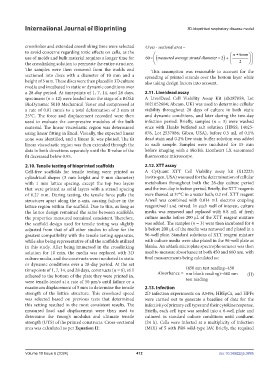Page 420 - IJB-10-6
P. 420
International Journal of Bioprinting 3D-bioprinted respiratory disease model
crosslinker and extended crosslinking time were selected Cross- sectionalarea =
to avoid concerns regarding toxic effects on cells, as the π ∗∗ 9mm
use of molds and bulk material requires a longer time for 60 × ( measured averagestranddiameter × ) +2
the crosslinking solution to permeate the entire structure. 2
The samples were then removed from the molds and This assumption was reasonable to account for the
sectioned into discs with a diameter of 10 mm and a spreading of printed strands over the bottom layer while
height of 5 mm. These discs were then placed in 3D culture also taking design factors into account.
media and incubated in static or dynamic conditions over
a 28-day period. At timepoints of 1, 7, 14, and 28 days, 2.11. Live/dead assay
specimens (n = 12) were loaded onto the stage of a BOSE A Live/Dead Cell Viability Assay Kit (ab287858, Lot
BioDynamic 5010 Mechanical Tester and compressed at 1021052604; Abcam, UK) was used to determine cellular
a rate of 0.01 mm/s to a total deformation of 2 mm at viability throughout 28 days of culture in both static
25°C. The force and displacement recorded were then and dynamic conditions, and later during the two-day
used to evaluate the compressive modulus of the bulk infection period. Briefly, samples (n = 3) were washed
material. The linear viscoelastic region was determined once with Hanks buffered salt solution (HBSS; 14025-
using linear fitting in Excel. Visually, the expected linear 076, Lot 2537086; Gibco, USA), before 0.5 mL of 0.1%
zone was identified, and a linear fit was plotted. The fit dead stain and 0.2% live stain buffer solution was added
linear viscoelastic region was then extended through the to each sample. Samples were incubated for 15 min
data in both directions separately until the R-value of the before imaging with a BioTek Lionheart LX automated
fit decreased below 0.95. fluorescence microscope.
2.10. Tensile testing of bioprinted scaffolds 2.12. XTT assay
Cell-free scaffolds for tensile testing were printed as A CyQuant XTT Cell Viability assay kit (X12223;
cylindrical shapes (3 mm height and 9 mm diameter) Invitrogen, USA) was used for the determination of cellular
with 1 mm lattice spacing, except the top two layers metabolism throughout both the 28-day culture period
that were printed as solid layers with a strand spacing and the two-day infection period. Briefly, the XTT reagents
of 0.27 mm. During testing, the tensile force pulls the were thawed at 37°C in a water bath; 0.2 mL XTT reagent
structures apart along the z-axis, causing failure in the A/well was combined with 0.014 mL electron coupling
lattice region within the scaffold. Due to this, as long as reagent/well and mixed. In each well of interest, culture
the lattice design remained the same between scaffolds, media was removed and replaced with 0.8 mL of fresh
the properties measured remained consistent. Therefore, culture media before 200 µL of the XTT reagent mixture
the scaffold design used for tensile testing was slightly was added. The samples (n = 3) were then incubated for 4
adjusted from that of all other studies to allow for the h before 200 µL of the media was removed and plated in a
greatest compatibility with the tensile testing apparatus, 96-well plate. Standard solutions of XTT reagent mixture
while also being representative of all the scaffolds utilized with culture media were also plated in the 96-well plate as
in this study. After being immersed in the crosslinking blanks. An xMark microplate spectrophotometer was then
solution for 10 min, the media was replaced with 3D used to measure absorbance at both 450 and 660 nm, with
culture media, and the constructs were incubated in static final measurements being calculated as:
or dynamic conditions over a 28-day period. At the set
timepoints of 1, 7, 14, and 28 days, constructs (n = 6), still (450 nm test reading−450
adhered to the bottom of the plate they were printed in, Absorbance = nm blank reading)−660 nm (II)
were tensile-tested at a rate of 50 µm/s until failure or a test reading
maximum displacement of 5 mm to determine the tensile 2.13. Infection
strength of the lattice structure. This crosshead speed 2D infection experiments on A549s, HBEpCs, and HPFs
was selected based on previous tests that determined were carried out to generate a baseline of data for the
this setting resulted in the most consistent results. The infectivity of primary cell types and their cytokine response.
measured load and displacement were then used to Briefly, each cell type was seeded into a 6-well plate and
determine the Young’s modulus and ultimate tensile cultured in standard culture conditions until confluent
strength (UTS) of the printed constructs. Cross-sectional (24 h). Cells were infected at a multiplicity of infection
area was calculated as per Equation II: (MOI) of 5 with PR8 wild-type IAV. Briefly, the required
Volume 10 Issue 6 (2024) 412 doi: 10.36922/ijb.3895

